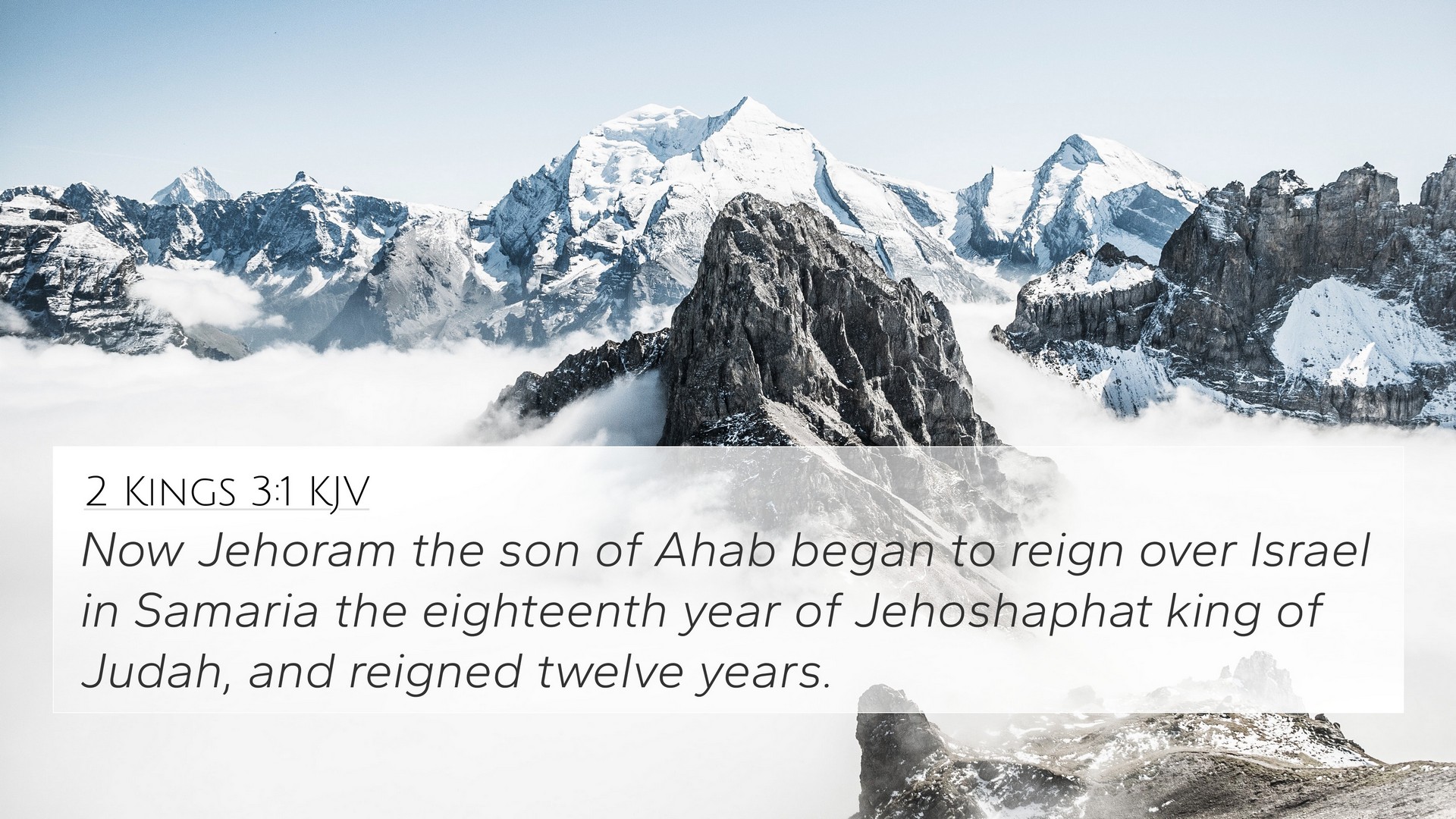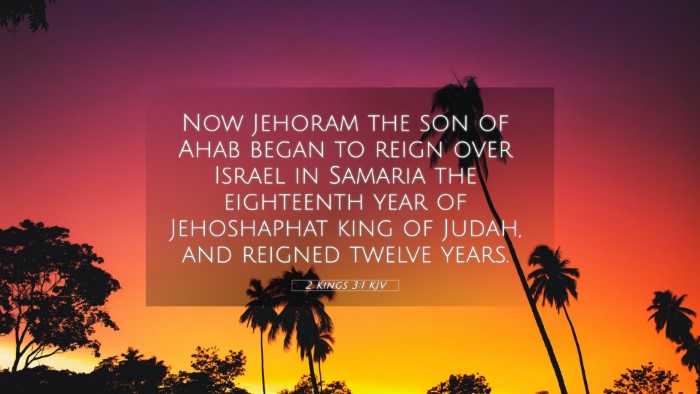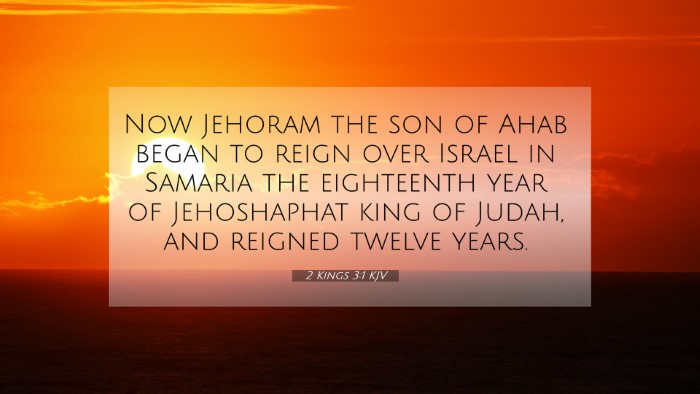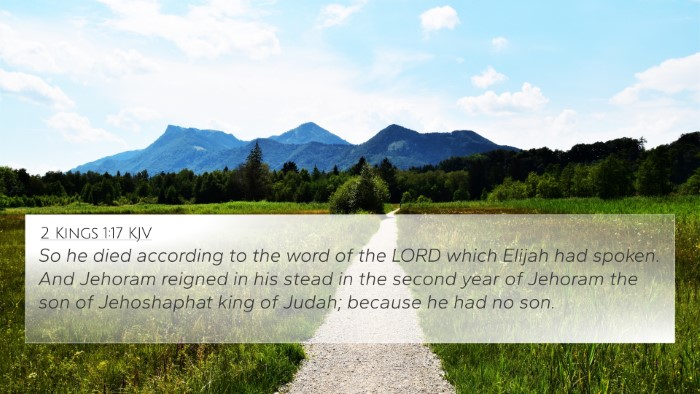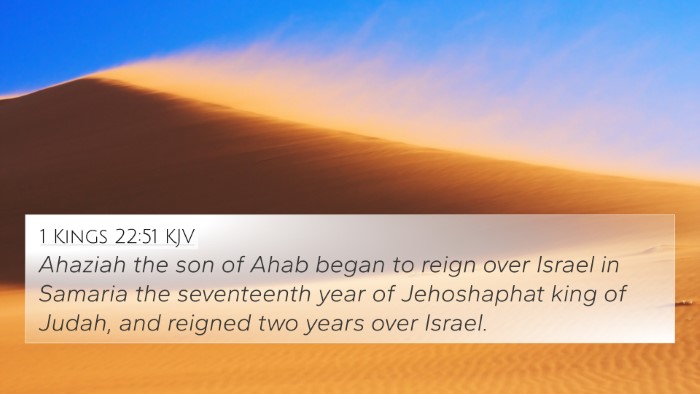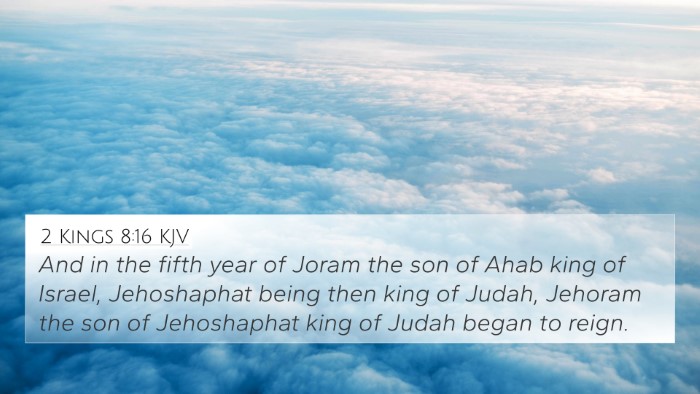Understanding 2 Kings 3:1
2 Kings 3:1 states: "Now Jehoram the son of Ahab began to reign over Israel in Samaria the eighteenth year of Jehoshaphat king of Judah, and reigneth twelve years." This verse sets the stage for a significant historical moment in the biblical narrative, connecting the reign of two kings and the ongoing tensions between the kingdoms of Israel and Judah.
Brief Overview
This verse introduces Jehoram (also referred to as Joram), the son of Ahab, marking his reign over the northern kingdom of Israel alongside Jehoshaphat, the king of Judah. It highlights political dynamics and the continuity of leadership following Ahab's reign, emphasizing the historical context and significance of this time period.
Commentary Insights
-
Matthew Henry:
Henry emphasizes that the mention of Jehoram in connection with Ahab serves as a reminder of Ahab's wickedness. Jehoram's ascension to the throne represents a continuation of Ahab's legacy but also indicates a partial shift, as Jehoram attempted to distance himself from some of his father's sins.
-
Albert Barnes:
Barnes highlights the geopolitical context, noting that Jehoram's reign occurs during a time when Israel was experiencing strife and conflict. The detail of the reign aligning with Jehoshaphat's long rule suggests a cooperative yet tumultuous relationship between Judah and Israel.
-
Adam Clarke:
Clarke draws attention to the importance of this transitional period. He notes that Jehoram's actions during his reign would lead to significant spiritual and theological implications for both kingdoms, revealing the consequences of leadership choices in a divided Israel.
Cross-Referencing Biblical Texts
To fully appreciate the depth of 2 Kings 3:1, it’s important to consider its connections with other scripture. Below are key Bible verses that relate to this passage:
- 1 Kings 22:51-53: This passage speaks about the evil reign of Ahab and contrasts it with Jehoshaphat’s relatively righteous rule.
- 2 Chronicles 21:1-6: This verse provides insights into Jehoram’s character and reign, illustrating his actions and their alignment or divergence from his father’s legacy.
- 2 Kings 1:1: This verse reveals the state of Israel under Ahab and sets the backdrop for Jehoram’s reign.
- 2 Kings 8:16-19: Discusses the kings of Judah and Israel, reflecting on their relationship, which is pivotal for understanding Jehoram’s leadership.
- 2 Kings 9:22: This shows the arrival of Jehu to eliminate the house of Ahab, indicating the ongoing conflict influenced by Jehoram’s rule.
- 2 Chronicles 22:1-4: Examines the relationship between Jehoram and the other kings of Israel and their impact on Judah.
- Isaiah 7:1-2: Describes the geopolitical climate involving Israel during Jehoram’s reign and its effects on neighboring nations.
- Micaiah's Prophecy (1 Kings 22:17): His prophecy about Ahab’s fate indirectly speaks to the implications for Israel under Jehoram’s leadership.
- 2 Kings 3:6-9: These verses focus on the military campaigns that Jehoram undertook, showcasing the transition into his reign’s actions and consequences.
- James 1:5: While not directly related to 2 Kings 3:1, this verse can be seen as a thematic counterpoint regarding wisdom in leadership, contrasting the decisions of Jehoram.
Thematic Connections
The narrative of Jehoram's reign allows for a deeper understanding of themes such as:
- Leadership and Legacy: Examining the impact of parental influence on leadership, particularly how Jehoram balances good and evil.
- Political Alliances: Understanding the complexities of cooperation between Israel and Judah and the resulting consequences.
- Spiritual Consequences: Evaluating how the actions of kings affect their nations, particularly regarding faithfulness to God.
Conclusion
In summary, 2 Kings 3:1 serves as a pivotal verse that not only introduces King Jehoram but also connects various threads of political, spiritual, and historical significance. The comprehensive analysis of this verse, together with its correlations to other biblical texts, provides a clearer picture of the complex environment in which these kings operated. For those seeking to deepen their understanding, utilizing tools for Bible cross-referencing, including concordances and study guides, can enrich one’s study and interpretation of these interconnected stories.
